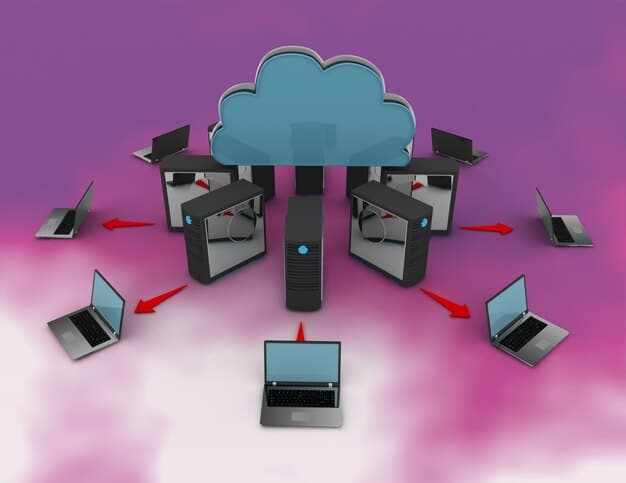Ransomware Attacks Surge: Protect Yourself Now!

Ransomware attacks have increased by 25% in the last three months, highlighting the urgent need for robust cybersecurity measures to protect individuals and organizations from becoming victims.
The threat of ransomware attacks increased by 25% in the last three months, creating a sense of urgency for individuals and businesses alike. This sharp rise underscores the pressing need for better security measures.
Understanding the Rising Threat of Ransomware
Ransomware is a type of malware that encrypts a victim’s files, rendering them inaccessible until a ransom is paid. The recent surge in attacks highlights the evolving sophistication of cybercriminals and the increasing vulnerability of digital systems. Understanding this threat is the first step toward protecting yourself.
What is Ransomware and How Does it Work?
Ransomware typically infiltrates systems through phishing emails, malicious websites, or software vulnerabilities. Once inside, it encrypts files, demanding a ransom payment, usually in cryptocurrency, for the decryption key.
Recent Ransomware Attack Trends
The last three months have seen a notable increase in ransomware attacks, targeting various sectors including healthcare, education, and finance. This rise is attributed to factors such as the increasing availability of ransomware-as-a-service (RaaS) and the exploitation of remote work vulnerabilities.
To better understand the scope of the ransomware threat, here are some key facts:
- Globally, ransomware attacks have risen by 25% in the past three months.
- The average ransom demand is now over $200,000.
- Small and medium-sized businesses (SMBs) are increasingly targeted.
- Healthcare and education sectors are particularly vulnerable.
In conclusion, the rise in ransomware attacks underscores the importance of proactive cybersecurity measures. Understanding the nature of the threat and the recent trends can help individuals and organizations better protect themselves.
Assessing Your Risk: Identifying Vulnerabilities
Before implementing preventive measures, it’s crucial to assess your current cybersecurity posture and identify potential vulnerabilities. This involves evaluating your systems, networks, and user behaviors to determine where you are most at risk.
Conducting a Cybersecurity Audit
A cybersecurity audit involves a comprehensive review of your IT infrastructure, policies, and procedures to identify weaknesses that could be exploited by ransomware. This includes assessing the security of your networks, servers, and endpoints.
Identifying Common Vulnerabilities
Common vulnerabilities include outdated software, weak passwords, unpatched systems, and inadequate employee training. Identifying and addressing these vulnerabilities is essential for reducing your risk of a ransomware attack.

Here are several key areas to focus on when assessing your risk:
- Software vulnerabilities: Regularly update software and patch known vulnerabilities.
- Password security: Enforce strong password policies and multi-factor authentication.
- Network security: Implement firewalls, intrusion detection systems, and network segmentation.
- Employee training: Educate employees about phishing and other social engineering tactics.
By thoroughly assessing your risk and identifying vulnerabilities, you can take targeted measures to strengthen your cybersecurity defenses and reduce your susceptibility to ransomware attacks.
Implementing Strong Cybersecurity Practices
Once you’ve assessed your risk, it’s time to implement robust cybersecurity practices to protect your systems and data. This involves a multi-layered approach that includes technical, administrative, and physical security measures.
Technical Security Measures
Technical security measures include implementing firewalls, intrusion detection systems, antivirus software, and endpoint detection and response (EDR) solutions. These tools help to detect and prevent ransomware from infiltrating your systems.
Administrative Security Measures
Administrative security measures include developing and enforcing security policies, conducting regular risk assessments, and providing employee training. These measures help to create a culture of security within your organization.
Implementing effective cybersecurity practices requires a comprehensive approach. Consider the following:
- Regularly update software and operating systems.
- Implement multi-factor authentication for all critical accounts.
- Use strong, unique passwords for all accounts.
- Segment your network to limit the spread of ransomware.
In summary, implementing strong cybersecurity practices is crucial for protecting against ransomware and other cyber threats. By combining technical and administrative measures, you can create a more secure environment.
The Importance of Regular Data Backups
Data backups are a critical component of any ransomware prevention strategy. In the event of a successful attack, having recent and reliable backups allows you to restore your data without having to pay the ransom. Regular backups can significantly mitigate the impact of a ransomware attack.
Creating a Backup Strategy
A comprehensive backup strategy should include regular backups of all critical data, both on-site and off-site. This ensures that you have multiple copies of your data in case of a disaster or ransomware attack.
Testing Your Backups
It’s not enough to simply create backups; you must also test them regularly to ensure that they can be restored successfully. Regular testing helps to identify any issues with your backup process and ensures that you can recover your data when needed.

Consider these best practices for data backups:
- Automate your backup process to ensure regular backups.
- Store backups in multiple locations, including off-site and cloud storage.
- Test your backups regularly to ensure they can be restored successfully.
- Encrypt your backups to protect them from unauthorized access.
In conclusion, regular data backups are essential for mitigating the impact of ransomware attacks. By creating a comprehensive backup strategy and testing it regularly, you can ensure that your data remains safe and recoverable.
Employee Training and Awareness
Employees are often the first line of defense against ransomware attacks. Educating them about the dangers of phishing, social engineering, and other cyber threats is crucial for preventing successful attacks. A well-trained workforce can significantly reduce the risk of ransomware infections.
Phishing Awareness Training
Phishing is one of the most common methods used to deliver ransomware. Training employees to recognize and avoid phishing emails is essential for preventing infections. This includes teaching them to scrutinize email senders, avoid clicking suspicious links, and report suspicious emails.
Promoting a Culture of Security
Creating a culture of security within your organization encourages employees to take cybersecurity seriously. This includes promoting open communication about security concerns, providing regular training updates, and recognizing employees who demonstrate good security practices.
Here are some key topics to cover in employee training:
- Identifying phishing emails and malicious links.
- Understanding the risks of social engineering.
- Using strong passwords and multi-factor authentication.
- Reporting suspicious activity to the IT department.
In short, employee training and awareness are critical for preventing ransomware attacks. By educating your workforce about the risks and promoting a culture of security, you can significantly reduce your organization’s vulnerability.
Incident Response Planning: What to Do After an Attack
Despite your best efforts, a ransomware attack may still occur. Having a well-defined incident response plan is crucial for minimizing the damage and restoring your systems as quickly as possible. An incident response plan outlines the steps to take in the event of a ransomware attack.
Developing an Incident Response Plan
An incident response plan should include procedures for identifying, containing, eradicating, and recovering from a ransomware attack. This includes assigning roles and responsibilities, defining communication protocols, and outlining steps for data recovery.
Steps to Take During a Ransomware Attack
If a ransomware attack occurs, the first step is to isolate the infected system to prevent the spread of the malware. Then, notify your IT department and begin implementing your incident response plan.
Key components of an incident response plan include:
- Isolation: Immediately isolate infected systems from the network.
- Investigation: Determine the scope of the attack and identify the source of the infection.
- Eradication: Remove the ransomware from infected systems.
- Recovery: Restore data from backups and verify system functionality.
In conclusion, having a well-defined incident response plan is essential for minimizing the impact of a ransomware attack. By outlining the steps to take in the event of an attack, you can ensure a swift and effective response.
| Key Point | Brief Description |
|---|---|
| 🛡️ Cybersecurity Practices | Implement firewalls, intrusion detection, and strong passwords. |
| 💾 Regular Backups | Back up data regularly and test the restore process. |
| 👨🏫 Employee Training | Educate employees on phishing and security protocols. |
| 🚨 Incident Response | Have a plan to isolate and recover from attacks. |
FAQ
▼
Ransomware is a type of malicious software that encrypts a victim’s files, rendering them inaccessible. Attackers then demand a ransom payment in exchange for the decryption key, essential for regaining access to the compromised data.
▼
Protecting against ransomware involves multiple layers of defense. These include updating software regularly, using strong passwords, enabling multi-factor authentication, and educating yourself and your team on identifying phishing attempts and suspicious links.
▼
If you suspect a ransomware attack, immediately disconnect the affected device from the network to stop the malware from spreading. Notify your IT department or a cybersecurity professional to assess the situation and initiate the incident response plan.
▼
Yes, absolutely! Regular and tested data backups are crucial. They allow you to restore your systems and data from a known good state without paying the ransom. Off-site storage of backups ensures they are not affected by the initial attack.
▼
It is generally not recommended to pay the ransom. There is no guarantee that the attackers will provide a decryption key, and paying encourages further criminal activity. Focus instead on isolating the infection and restoring your data from backups.
Conclusion
In conclusion, the rise in ransomware attacks increased by 25% in the last three months demands immediate and comprehensive action. By implementing strong cybersecurity practices, maintaining regular data backups, training employees, and developing an incident response plan, individuals and organizations can significantly reduce their risk of becoming victims. Stay vigilant, stay informed, and prioritize cybersecurity to protect your valuable data.





